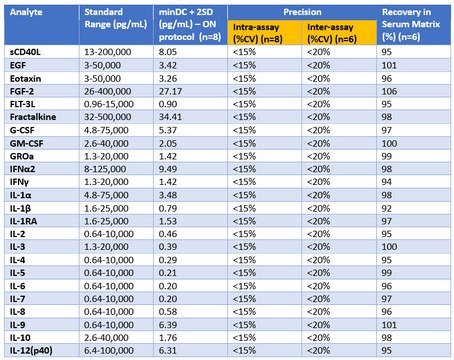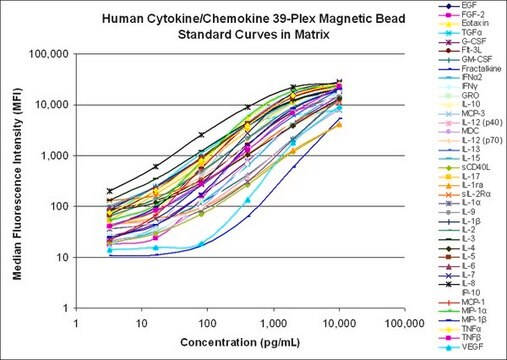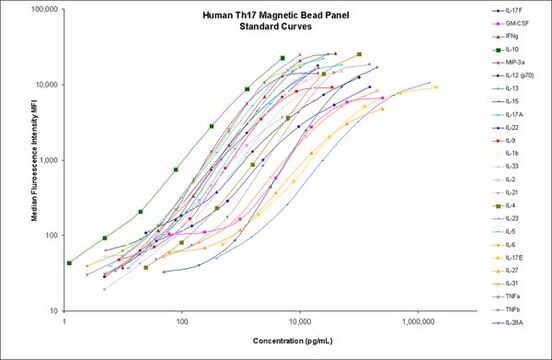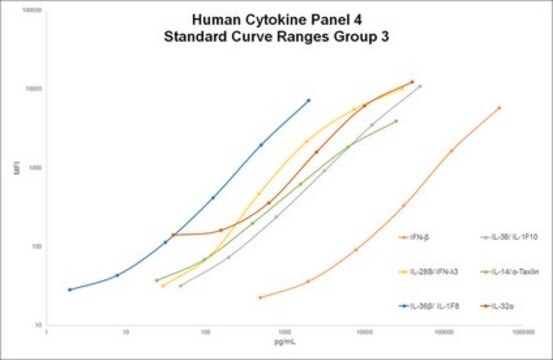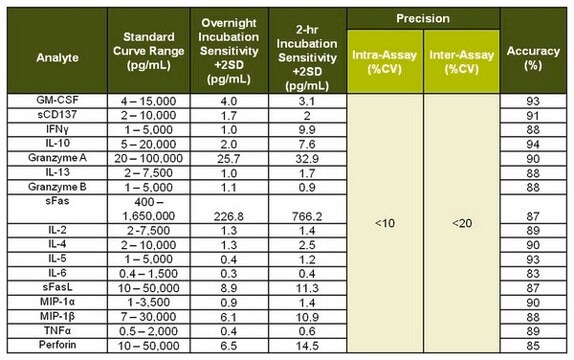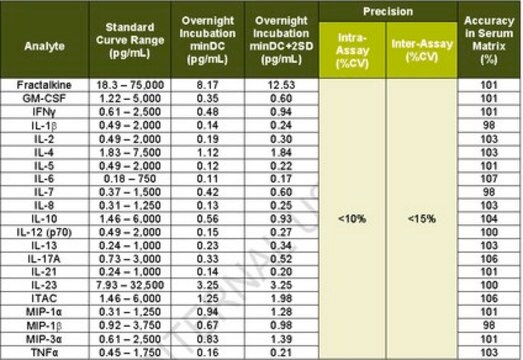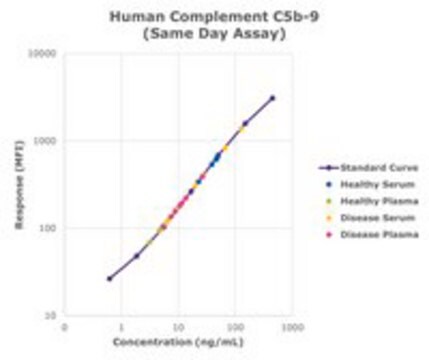HCD8MAG-15K
MILLIPLEX® Human CD8+ T Cell Magnetic Bead Panel - Immunology Multiplex Assay
Simultaneously analyze multiple cytokine and chemokine biomarkers with Bead-Based Multiplex Assays using the Luminex technology, in human serum, plasma and cell culture samples.
Synonym(s):
Human CD8 T cell cytokine panel, Human cytokine multiplex kit, Luminex® human cytokine immunoassay, Millipore human cytokine panel
About This Item
Recommended Products
Quality Level
species reactivity
human
manufacturer/tradename
Milliplex®
assay range
standard curve range: 0.4-1,500 pg/mL
(IL-6)
standard curve range: 0.5-2,000 pg/mL
(TNFα)
standard curve range: 1-3,500 pg/mL
(MIP-1α)
standard curve range: 1-5,000 pg/mL
(Granzyme B)
standard curve range: 1-5,000 pg/mL
(IFNγ)
standard curve range: 1-5,000 pg/mL
(IL-5)
standard curve range: 10-50,000 pg/mL
(Perforin)
standard curve range: 10-50,000 pg/mL
(sFasL)
standard curve range: 2-10,000 pg/mL
(IL-4)
standard curve range: 2-10,000 pg/mL
(sCD137)
standard curve range: 2-7,500 pg/mL
(IL-13)
standard curve range: 2-7,500 pg/mL
(IL-2)
standard curve range: 20-100,000 pg/mL
(Granzyme A)
standard curve range: 4-15,000 pg/mL
(GM-CSF)
standard curve range: 400-1,650,000 pg/mL
(sFas)
standard curve range: 5-20,000 pg/mL
(IL-10)
standard curve range: 7-30,000 pg/mL
(MIP-1β)
technique(s)
multiplexing: suitable
detection method
fluorometric (Luminex xMAP)
shipped in
wet ice
General description
The Luminex® xMAP® platform uses a magnetic bead immunoassay format for ideal speed and sensitivity to quantitate multiple analytes simultaneously, dramatically improving productivity while conserving valuable sample volume.
Panel Type: Cytokines/Chemokines
Specificity
Application
- Analytes: GM-CSF, sCD137, IFNγ, sFas, sFasL, Granzyme A, Granzyme B, IL-2, IL-4, IL-5, IL-6, IL-10, IL-13, MIP-1α, MIP-1β, TNF-α, Perforin
- Recommended Sample type: serum, plasma or tissue/cell lysate and culture supernatant
- Recommended Sample dilution: Neat
- Assay Run Time: Overnight
- Research Category Inflammation & Immunology
Features and Benefits
Storage and Stability
Other Notes
Legal Information
Disclaimer
Signal Word
Danger
Hazard Statements
Precautionary Statements
Hazard Classifications
Acute Tox. 4 Dermal - Acute Tox. 4 Inhalation - Acute Tox. 4 Oral - Aquatic Chronic 2 - Eye Dam. 1 - Skin Sens. 1 - STOT RE 2
Target Organs
Respiratory Tract
Storage Class Code
10 - Combustible liquids
WGK
WGK 3
Certificates of Analysis (COA)
Search for Certificates of Analysis (COA) by entering the products Lot/Batch Number. Lot and Batch Numbers can be found on a product’s label following the words ‘Lot’ or ‘Batch’.
Already Own This Product?
Find documentation for the products that you have recently purchased in the Document Library.
Related Content
Immunology multiplex assays, like MILLIPLEX® assays, allow researchers to investigate more immune biomarkers simultaneously, saving time and resources. This is especially critical to immunology research, where numerous analytes play a role in different pathways.
See how multiplexing the inflammation signaling pathway with MILLIPLEX® inflammation assays or cell signaling assays can help researchers bridge the gap between immunology and cell signaling, including investigating T cell signaling, Th Cell differentiation, inflammatory response signaling, and sepsis signaling.
See how MILLIPLEX® multiplex immunoassays offer researchers the ability to simultaneously quantitate a large number of human cytokines, chemokines, and growth factors, and detect human immunoglobulins against SARS-CoV-2 antigens, to better understand the immune response to COVID-19, including cytokine storm.
Our team of scientists has experience in all areas of research including Life Science, Material Science, Chemical Synthesis, Chromatography, Analytical and many others.
Contact Technical Service